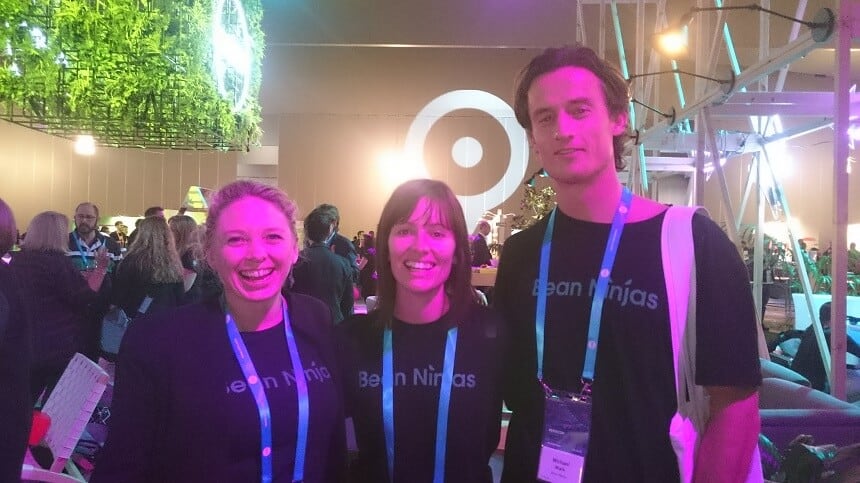Article Contents
Xerocon Melbourne 2017
Recently Bean Ninjas, Colleen Heggarty and Michael Wark joined Founder Meryl Johnston at Xero’s annual conference Xerocon Melbourne 2017 to explore the constantly evolving world of Xero for its Australian, Asian and New Zealand partners.
Both Colleen and Michael were first timers to Xerocon. Both were blown away by the size and brilliance of it all. Over 3000 people from 19 countries descended on Melbourne to workshop, talk, discuss, question and network all things Xero.
Colleen and Michael take us through two of the hot topics from this years conference:
Getting lean and getting cyber smart.
Colleen’s Xerocon Update – Cybercrime and your business
Could your business afford to write a cheque for $6,600 and receive nothing in return? Not many could, but that is the cost of cybercrime on average to every small business, depending on where you are based this figure could be more.
One of the most memorable presentations for Colleen, was from Xero Head of Security, Paul Macpherson, who spoke frankly about the increasing risk of fraud and cybercrime and the threat it poses to all businesses. With cloud accounting and e-commerce booming, online criminal activities are also on the rise.
These days many fraudster emails are commonplace and can be easy to pick, but the type of attacks are growing in sophistication leaving us all vulnerable.
How big is the problem?
It’s big. Sources vary, some say losses from online scams for Australia alone, are reported be around $300 million each year, whilst the Australian Crime Commission believes that figure is closer to $1 billion. Of this, small businesses in Australia are hit $6,600 per annum on average.
This seems bad, but the figures in the US are staggering, four years ago the cost of cybercrime surpassed $100 billion, and today, a cyber crime incident in the US costs a company an average of $15.4 million. An average!
And all sources agree that these numbers are increasing at equally gob-smacking rates.
Oftentimes, banks, government, healthcare, councils and big business are the targets, making up these huge numbers and also attracting media attention.
However, small businesses, whilst they don’t attract the big headlines, make great cybercrime targets. They have an online presence – with email details readily available. They are used to paying accounts online – and are used to paying them quickly. Further, small businesses are thought to neglect improving systems and data security as they have less to invest in defend themselves than larger businesses.
What should I look out for?
One of the prevailing scams for small businesses currently on the rise are invoice scams.
Scammers will find an invoice, copy an invoice changing some of the details (i.e. the reference number, the payment account) and then resend the invoice. Too easy.
Unfortunately, in most cases the loss incurred cannot be recovered via insurance as often occurs with a fraudulent transaction, as the banks did not authorize the transfer of funds. The responsibility for the erroneous transfer rests with the business. It is the business’s responsibility to transfer funds to the correct account. It would be the same if a business incorrectly entered the account number and paid away to an incorrect account.. the funds are gone and can’t be recovered.
Think it won’t happen to you? Brisbane City Council lost almost half a million dollars by paying out 9 fake invoices. Nine.
No one is immune, even Google and Facebook have been swindled over $100 million and they know a thing or two about about digital security.
The website https://haveibeenpwned.com/ provides some insight into how many times popular websites have been attached (including successful attacks). Linkedin has been attacked some 164 million times whilst Dropbox experienced 68 million records being traded after an incursion in 2012.
Scams have come a long way since the Nigerian scam emails, which many of us have received, yet these are still about and evolving. These scammers have targeted Xero, but have failed to understand that Xero is a cloud accounting system – the scammers mistakenly believe that Xero is a bank.
Colleen has witnessed this first hand, when a concerned client called to check whether there had indeed been a transfer of $30,000 to his account by Xero, as had been claimed in an email he had received. The email indicated that the $30,000 had been transferred to him, but could the client could kindly…. confirm his account details… Of course there had been no transfer, the scam was yet to unfold with the scammers seeking bank account details.
How can I protect my business?
- Know your suppliers. Call them. Verify the invoice. Make this a process if necessary. Small businesses have an advantage here, they have a smaller number of creditors to manage.
- 2 Factor Authentication (2FA) is one of the best ways to limit fraud or scams. 2FA occurs where there is a second line of identification to access a platform i.e. in addition to a password a code may be sent to your phone. Many platforms offer this now.
- Passwords. An 8 character password just takes 30 minutes to crack. The time it takes to meet a friend and have a coffee. A 14 character password, on the other hand – takes 2 weeks to crack. This is simple maths. The combinations to break the code increase with every letter (or symbol or number) you add. And be sure to add them! Avoid dictionary words. How to remember a really long password? Have each letter be the word to a favourite song or phrase YWAOMM (can you pick the Elvis song?) and break it up with characters and numbers.
- Password Manager – use a secure online password manager like Lastpass. This helps you not just secure passwords securely, but you will also avoid using the same password repeatedly.
Want to know more or think you may have been scammed? Learn how to protect your business from fraud using Xero here.
Michael’s XeroCon Update – Being Lean
For Michael, the biggest influence at Xerocon was the emphasis on the pursuit of productivity, for both bookkeeping businesses and their clients. With ongoing technological and conscious improvements, we are headed toward a future with less time “processing” and more time value-adding for our customers. As bookkeepers, by providing timely, accurate and insightful data, we empower our customers to run the best businesses they can. By going beyond bookkeeping and providing, for example, management reports, we can offer our clients more!
Michael was extremely impressed by the application of lean management theories to the Xero accounting and bookkeeping environment as a way of keeping ahead of the game and providing customers the very best service.
But Lean isn’t just for bookkeepers or accountants.
Lean has long been embraced by manufacturing, logistics and service provision businesses and the introduction of ever advancing cloudware and technology brings further enhancement to this way of management for all businesses.
Lean efficiency is about a day-by-day improvement of processes that your customers value. It is a long-term commitment to a new way of working, not a specific tool or initiative. It starts from the bottom, those who do the work, who know the work and are most, affected by the work, are best to run these improvements.
Being lean
Being lean is about:
- Culture – A continuous improvement culture: Nobody has ALL the solutions; it’s about the team suggesting ideas, and having a culture that fosters this.
- Knowing Where You Are Going – Mapping the ideal state that we would like to be in. First map out current processes, then you map out where you would like to be to create a clear roadmap of how to move forward.
- Identifying & Eliminating Waste – Eliminating unnecessary processes,that don’t contribute to your goals or add value to your customers.
Identifying waste
How do you as a business identify waste, we all know what it is, but how can you define it or categorize it? Waste is more about what something is not; useful.
Tasks are either;
- Value added: customer wants, activity that transforms or shapes material or information.
- Non-value added but needed: doesn’t add value but can’t eliminate as is legally required, or current state of technology or thinking prevents it.
- Non-value added & not needed: consumes resources but create no value in eyes of customer.
What does waste look like? Waste may be present in your business in the following forms: defects, overproduction, waiting for the next step to happen, non-utilized talent, unnecessary transport, excess inventory, unnecessary movements or extra processing (more work than required by customer).
These are common occurrences in many businesses – once we have identified waste, how can we reduce or eliminate it?
Eliminating waste
There are many solutions to reducing and eliminating waste and these will vary in each instance, across various businesses, industries and time.
Solutions can be found in using advisors or outsourcing, for example accountants, bookkeepers, or marketing firms.
Given the wide array of tech tools available these days many solutions to identifying holes in production can be found with the right technology, an excellent example of this is real time inventory or logistic systems.
Simply writing a plan and defining goals can be a simple tool to keep everyone on track with the organization’s goals. If it’s not contributing towards achieving those…. Is it necessary? A lot of time can pass between when we sit down as business owners to define our goals. Sometimes those goals move and we may not have considered this ourselves, or, communicated it to the team. Thus we are left with processes, products and services that are not helping us achieve our goals. Sometimes we may have achieved our initial goal, so it’s time to move on to the next one.
Often we assume what our value our business provides to our clients, but often it may not be what you think, or not even your core purpose. Understanding your value to your clients and potential clients is essential to identifying essential and nonessential, as well as value-add and non-value add activities.
These can be found by mapping your value stream, and asking your customer what they actually value.
Maximizing efficiency
Eliminating waste is one side of the Lean coin, the other is to maximize efficiency. Surely, we are already operating as efficiently as possible? No one wants to be running an inefficient business? But inefficiencies can creep in, they might be “ways we have always done things”, band-aid solutions that have been kept around with other band-aids added on. In fast moving business environments it can be challenging to find the time to come back to revisit or overhaul processes if needed.
Some tools to maximize efficiencies may include;
- Using external consultants to get an opinion – sometimes you need to go outside the business to have someone objectively look at gains to be made.
- Get active feedback from customers via a focus group or survey – customers are a wealth of information about how you could be doing your job of providing them a product or service better.
- Know what people like doing, what drives them – delay and procrastination are the hallmark of an unenergized and unmotivated employee. If someone isn’t the right fit for a role, these days there is an infinite pool of talent to draw from and likewise infinite work opportunities available. Putting people in an environment where they thrive will have enormous flow on effects for your business.
Want to get lean?
These are just some of the key points raised in relation to Lean and Xerocon, if you would like to learn more check out this Xero Webinar given by NZ Business Director, Emma Crawford-Falekaono.







